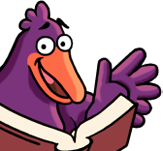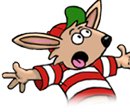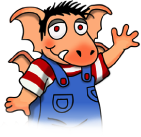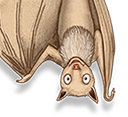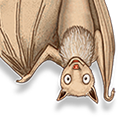Title
subtitle
The initial idea for Living Books came to me when I was a kid. I always wanted to go inside Dr. Seuss's Horton Hears a Who! book and play with all the weird and fantastical instruments and contraptions to see what they would do. Then I got into children's software in 1987 because I couldn't find anything "educational" my boys wanted to play with at the time. I saw how engaged they could be for hours on end with a Nintendo game, but getting these same boys to do even a half hour of homework was a very different story. I was inspired to create something with the ability to delight and engage kids but that also had real learning content as well. This is where the concept for Living Books came to life.
The important thing was to have Living Books really work for kids, so we watched them play with the prototype and listened to their feedback. I had seen many products made "for kids", but seldom "with kids". I wanted to understand what excited and engaged them rather than assume from my adult perspective that I knew. And teach me they did. All these years later I am still a giant fan of kid-informed design.
We also talked to classroom teachers to find out that they wanted and needed. Teachers immediately understood and loved the learning potential they saw in all the interactive words, but their main request was, "Make it easy to use, I don't have time to be the technologist and the teacher." Just put a disc in and it plays, that was our final solution and it came directly from teachers.
As the first months passed, it began to look like Living Books had something unique about it and our first programmer (Michael Coffey) was added to help think about how we might make it work. The prototype was cute and the experience was good, but could we actually make something dance from a CD-ROM, which at the time had delayed reactions (up to a minute wait) when you clicked on something – not exactly interactive.
We picked our first title, Mercer Meyer's Just Grandma and Me, and more people where allocated to work on it. Barbara Lawrence began working on the digital backgrounds, and Don Albretch, an older Disney animator began helping me with animations. Since multimedia was a new thing, Broderbund didn't yet have a recording studio and we did every audio take in a small office, one at time, stopping to save and start again. Tom Rettig, the only sound person at that time, did all of the very early recording.
With the support of Broderbund management, we became the Living Books group, moved to a small open office area above shipping and receiving and added animators, Bridget Erdman, Michael Dashow, and Donna Bonifield, as well as our first full time sound designer and musician, Joey Edleman, who wrote our Living Books theme and many of the dances themes for our early stories.
We also added a team of programmers. Up to this point, most products were built by one primary programmer per title, with some help on pieces along the way. But for Living Books I wanted an engine that was cross platform (could easily play on Mac, PC, or more), driven by the animation needs (since it was expensive we only wanted to draw it once), AND (this was a big one) turned the CD-ROM from a storage device into a highly interactive player – not like anything I had seen done at this point.
To accomplish this, Broderbund supplied me a great mixed team of programmers. We had senior systems guru Glenn Axworthy, Dave Lucas working on audio, Mark Webster on (trombone?), and Matt Siegal working with all our animation graphics. In my mind these guys are the hidden magic behind Living Books because they were able to make the pages load, characters dance, and everything feel interactively "right" while making it look simple to do, when it was anything but. Mickey Mantle also joined Broderbund at this time as CTO and became a Living Books advocate.
We had a variety of great Broderbund producers work with us in the early years: Clair Curtain, Todd Power, and Rob Martyn all helped us stay on task. We released our first title, Mercer Mayer's Just Grandma and Me in 1992, hoping there was a big enough installed base of CD drives to use it. Our worries were short lived as sales projections where surpassed by a factor of 10 in the first six months.
As our first titles sold well we were able to add more artists and musicians to our team, and we all moved to the new Broderbund office in Novato, CA. About this time Alberto Vitale, head of Random House Publishing saw a demo of Just Grandma and Me at the American Booksellers Association convention, and was excited because they didn't have the digital rights to Dr. Seuss and it looked like it might go somewhere else (not something they wanted to happen, having been Dr. Seuss' main publisher since early on.)
They came to us and asked if we could create a demo to show Audrey Geisel, Mrs. Dr. Seuss and rights holder to all the Seuss titles. We agreed, and I put together a special demo that showed how a Dr. Seuss title might look. I also incorporated Broderbund's paint product, Kid Pix, with Seuss stickers from his I Can Draw It Myself book. We met in La Jolla, California with Audrey sitting amongst a line of her intellectual property lawyers, Alberto from Random House, Doug Carlston (now CEO of Broderbund), John Baker (my boss), and me.
Applications
Platforms
© 2025 Wanderful, LLC (DBA: Wanderful Edutainment and Wanderful Interactive Storybooks). A Jordan Freeman Group Company. Powered by ZOOM Platform. All Rights Reserved. Living Books is a registered trademark of Houghton Mifflin Harcourt, used with permission. Arthur, © Marc Brown Studios, All Rights Reserved. Little Critter, Little Monster, © Mercer Mayer, All Rights Reserved.
